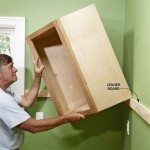What Is A Normal Kitchen Trash Can Size?
Determining the normal size of a kitchen trash can involves considering several factors, including household size, waste generation habits, kitchen space constraints, and personal preferences. There isn't a singular "normal" size that applies universally. Instead, a range of common sizes caters to different needs. This article examines the typical size ranges for kitchen trash cans and explores the considerations that influence selecting the most appropriate size for a given household.
Kitchen trash cans are essential for maintaining a clean and sanitary environment. They serve as receptacles for food scraps, packaging materials, and other household waste generated daily. The size of the trash can directly impacts how frequently it needs to be emptied, which in turn affects convenience and hygiene. Choosing the right size prevents overflowing, minimizes odors, and ensures the can fits comfortably within the available kitchen space.
Understanding Common Kitchen Trash Can Sizes
Kitchen trash cans are typically measured in gallons (or liters in some regions). The most common sizes range from small countertop models to larger, freestanding units. Understanding these size ranges is crucial for making an informed decision.
Small trash cans, typically ranging from 1 to 5 gallons, are often used as countertop compost bins or bathroom trash cans. They are suitable for individuals or small households who generate minimal waste or for specific waste streams like food scraps. Due to their compact size, they do not require significant floor space and can be easily placed on countertops or under sinks.
Medium-sized trash cans, ranging from 7 to 13 gallons, represent a popular choice for many households. These cans offer a balance between capacity and space efficiency. They are large enough to accommodate a reasonable amount of daily waste without requiring excessively frequent emptying. This size is often favored in standard-sized kitchens with moderate waste generation.
Large trash cans, ranging from 13 to 20 gallons or more, are designed for larger households or those who generate significant amounts of waste. Families with multiple members, individuals who frequently cook at home, or those with a tendency to accumulate packaging waste may find a large trash can more suitable. These cans typically require more floor space and may be equipped with features like wheels or handles to facilitate easier movement.
Extra-large trash cans, exceeding 20 gallons, are generally used in commercial settings or very large households. They are capable of holding substantial amounts of waste and are often constructed from durable materials to withstand heavy use. These sizes are less common in residential kitchens due to their considerable size and capacity.
Factors Influencing Trash Can Size Selection
Several factors play a significant role in determining the ideal kitchen trash can size for a particular household. These factors should be carefully considered to ensure the chosen size aligns with the specific needs and circumstances of the residents.
Household size is a primary determinant. Larger households naturally generate more waste than smaller households. A single-person household may find a 7-gallon trash can sufficient, while a family of four may require a 13-gallon or larger option.
Waste generation habits also influence the necessary trash can size. Individuals who frequently cook at home and generate a significant amount of food waste may require a larger capacity. Similarly, households that accumulate a substantial amount of packaging waste, such as cardboard boxes and plastic containers, may benefit from a larger trash can.
Kitchen space constraints are a practical consideration. The available floor space in the kitchen directly impacts the maximum size of the trash can that can be accommodated. A small kitchen may only have room for a smaller, more compact trash can, while a larger kitchen may be able to accommodate a larger bin without compromising functionality or aesthetics.
Desired emptying frequency is another important factor. A smaller trash can will need to be emptied more frequently than a larger one. Individuals who prefer to empty their trash less frequently may opt for a larger capacity, while those who prefer to empty it more often may choose a smaller size.
Personal preferences also come into play. Some individuals prefer the convenience of a larger trash can, even if they don't necessarily need the extra capacity, while others prefer the space-saving benefits of a smaller bin. Aesthetic considerations may also influence the choice, with some individuals preferring trash cans that blend seamlessly with their kitchen décor.
Specific Trash Can Types and Their Typical Sizes
Beyond the overall gallon capacity, the type of trash can also influences its size and suitability for different applications. Different trash can designs cater to specific needs and preferences. Here are a few common types and their typical size ranges:
Step-on trash cans are a popular choice for kitchens due to their hands-free operation. These cans typically range from 7 to 13 gallons. The foot pedal allows for easy opening and closing, promoting hygiene and convenience. The size of these cans is often determined by the internal bucket capacity rather than the overall external dimensions.
Motion sensor trash cans offer another hands-free option. These cans utilize sensors to detect movement, automatically opening and closing the lid. They typically range from 7 to 13 gallons, similar to step-on cans. The hands-free operation is particularly beneficial in kitchens where hygiene is a primary concern.
Pull-out trash cans are designed to be integrated into kitchen cabinets. These cans are typically smaller, ranging from 5 to 10 gallons, to fit within the cabinet's dimensions. They offer a discreet and space-saving solution for waste disposal, concealing the trash can from view.
Countertop compost bins are small, typically ranging from 1 to 3 gallons. They are designed for collecting food scraps and organic waste for composting. These bins are often placed on countertops for easy access during food preparation.
Recycling bins are often similar in size to standard trash cans, ranging from 7 to 20 gallons. They may be distinguished from standard trash cans by their color or labeling, indicating that they are intended for recyclable materials.
When selecting a kitchen trash can, it's important to consider the specific type of waste it will primarily hold. For instance, a household that generates a significant amount of recyclable materials may want to consider allocating a suitably sized recycling bin to avoid mixing refuse.
In summary, while a "normal" kitchen trash can size is subjective and depends on various factors, the 7-13 gallon range represents a common and versatile option for many households. Careful consideration of household size, waste generation habits, kitchen space, desired emptying frequency, and personal preferences will lead to the selection of the most appropriate size for individual needs. By understanding the available sizes and the factors that influence their suitability, consumers can make informed decisions and optimize their kitchen waste management practices.

What Size Trash Can Is Right For Your Home Kitchen Cans Unlimited

What Size Trash Can Is Right For Your Home Kitchen Cans Unlimited

What Size Is A Kitchen Trash Can Ultimate Guide

Garbage Bags Sizes

What Size Trash Can For Kitchen Is Best Plastic Place

Yrllensdan Garbage Can 13 Gallon 50 Liter Kitchen Trash For Bathroom Bedroom Home Office Automatic Touch Free High Capacity With Lid Brushed Stainless Steel Waste Bin Blue Com

Hdx 8 Gal Flap Tie Medium Kitchen Trash Bags 50 Count Hd08wc050w The Home Depot

Sterilite 13 Gallon Trash Can Plastic Swing Top Kitchen Black Com

Average Kitchen Trash Can Size Essential Guide For Your Home

Types Of Trash Cans Recycling Bins Webstaurant
Related Posts








